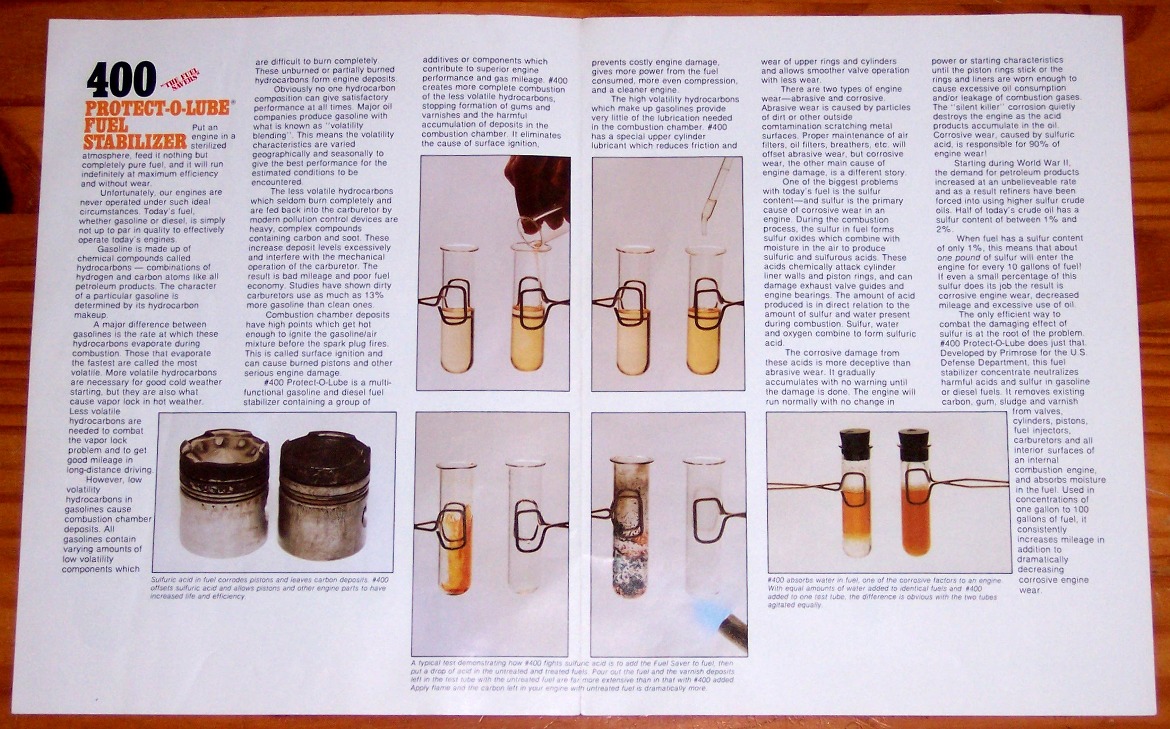
 
     |
| Fuel Stabilizer: Neutralizes Acids, Removes Carbon, Reducers Friction & Engine Wear! (Page 1/1) |

|
Vintage-Nut
|
AUG 15, 06:46 PM
|
|
It all is true plus increasing fuel mileage too; but I need to back-up to the beginning….
Introduction
My Primrose salesman phones me the other day to check if I needed more fuel stabilizer. After the call, I thought to myself “Hey Vintage-Nut, why not share this valuable Primrose story with PFF members?”
A long time ago in our galaxy….
My father started selling Primrose Oil Company products early in the 80’s and I really noticed one particular product called ‘400 Protect-O-Lube’.
The pamphlet said that this fuel stabilizer neutralizes the corrosive effects of engine acids and sulfur in gasoline created during combustion. It also removes existing carbon and varnish from valves, cylinders, pistons, carburetors, fuel injectors and all interior surfaces of an internal combustion engine, improves combustion, lubricates top rings and improves flexing, reducers friction and also absorbs moisture in the fuel.
Photo of the 1980 Pamphlet

Uh-huh, yeah - I heard about other ‘snake oil’ products before, but my father was using it and he offered me a free gallon of 400 Protect-O-Lube to try….
I rode mainly two-stroke motorcycles which all had a common problem - low compression or piston ring ‘blow-by’. I would replace the rings often which were generally ‘stuck’ in the piston ring grooves.
After using 400 Protect-O-Lube in my main motorcycle; I checked on the rings and WOW, they were completely relaxed! Very impressive achievement.
I also had a Ford V8 which had low compression in the 120-psi range, so I removed the spark plugs; put in an ounce of 400 Protect-O-Lube in each cylinder; cranked it a few times; installed new spark plugs, treated the fuel tank and fired-up the engine. A lot of exhaust smoke as 400 Protect-O-Lube started to clear out the carbon and after, the engine ran smoother.
After using the full tank of treated gas of the Ford V8, I check the compression again which was higher in the 150-psi range. I was a believer of 400 Protect-O-Lube!
Present Time
All of my vehicles including my Fiero have been using Protect-O-Lube for decades and Primrose Oil Company sold the product in 6-gallon pails, four pails a pallet.
In the 2000’s, Primrose Oil Company added a concentrated fuel stabilizer called 403 Plus which I changed because of the volume of shipping. 400 and 403 are really the same product but one is concentrated and the other isn’t.
In never treated engines, I use 1.28 oz of 403 Plus lube in each gallon of gasoline in the first tank and treat the cylinders too. The next tank I use around 0.5 oz in each gallon of gasoline and as a maintenance dose I use 0.2 oz in each gallon of gasoline in every tank.
Reducing Fleet Maintenance Issues
Protect-O-Lube® Fuel Stabilizer Increases Engine Life with Proof of Case Studies & White Papers on-line if you search.
My highest mileage vehicles to date are a 1992 Honda 1.6L VTEC with 256K miles and a 1998 Ford 3.0L V6 with 231k miles. Both start and run without problems nor consuming engine oil and passing smog every time….
400 Protect-O-Lube® was developed for the U.S. Defense Department in the early 1940's.
https://www.primrose.com/Prod_detail.php?ID=39
https://www.primrose.com/im...s/tds/PS_TDS_400.pdf
403 Protect-O-Lube® Plus is newer as a concentrate.
https://www.primrose.com/Prod_detail.php?ID=41
https://www.primrose.com/im...s/tds/PS_TDS_403.pdf
Protect-O-Lube Plus Reduces Water in Ethanol Fuels Too!
There are numerous drawbacks of ethanol in all grades of gasoline and the concerns are warranted. Like brake fluid, ethanol is “hygroscopic” too and will actually attract/draw water from the air; please read this Technical Bulletin:
https://www.primrose.com/im...Fuels.pdf?TechInfo=2
As I said in the beginning; “why not share this valuable Primrose story with PFF members?” So, either you don’t believe a word of these products or you’re already using a fuel stabilizer which I recommend 403 Plus.
Enjoy,
|
|
    
  |
|















